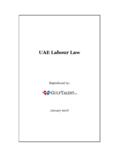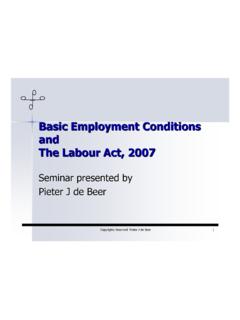Transcription of FEMALE LABOUR FORCE PARTICIPATION: 1 - …
1 OECD Economics Department, May 2004 1 FEMALE LABOUR FORCE participation : PAST TRENDS AND MAIN DETERMINANTS IN OECD COUNTRIES1 Introduction and summary The FEMALE participation rate is depressed by policy and market failure FEMALE LABOUR - FORCE participation is much lower than men s in many countries. These differences are to some extent rooted in culture and social norms but they also reflect economic incentives. The FEMALE participation behaviour has attracted increasing interest because of concerns that population ageing will put downward pressure on LABOUR supply, with negative implications for material living standards and public finances. An increase in FEMALE participation could help mitigate This paper focuses on the effects of market failures and policy distortions in depressing FEMALE participation and the likely results of policy reforms.
2 The main findings of the paper can be summarised as follows: A more neutral tax treatment of second earners in a household compared with single earners leads to an increase in FEMALE participation . Childcare subsidies and paid parental leaves boost FEMALE participation , but child benefits reduce it. More part-time work opportunities, through policies that remove distortions against part-time work, increase FEMALE participation . Simulations of comprehensive policy reforms in these areas suggest that they could close most of the gap between participation rates of prime-age women and men. 1. This paper is based on recent, more detailed OECD research (Jaumotte, 2003).
3 2. See Burniaux et al. (2003). OECD Economics Department, May 2004 2 Trends in FEMALE participation Large cross-country differences persist Over the past few decades, the LABOUR FORCE participation of women has increased strongly in most OECD countries. This process started earlier in some countries ( the Nordic countries and the United States). More recently the increases have been greatest in countries where FEMALE participation was particularly low. This development has narrowed cross-country differences somewhat, but they still remain large (Figure 1). The participation rates of prime-age women (aged 25-54) range from about 60 per cent (or below) in Korea, Mexico, Turkey and Southern European countries (with the exception of Portugal) to well above 80 per cent in the Nordic countries and some Central European countries.
4 Figure 1. The LABOUR FORCE participation of women has strongly increased1. 1983 for Greece and Luxembourg, 1986 for New Zealand, 1988 for Turkey, 1991 for Switzerland, Iceland, and Mexico, 1992 for Hungary and Poland, 1993 for the Czech Republic, 1994 for Austria and the Slovak : OECD LABOUR Market FORCE participation rates of prime-age women (aged 25-54)0102030405060708090100 TurkeyMexicoKoreaItalySpainGreeceLuxembo urgIrelandJapanHungaryBelgiumAustraliaNe therlandsNew ZealandUnited KingdomUnited StatesPolandAustriaPortugalGermanyFrance CanadaSwitzerlandCzech RepublicNorwayDenmarkSlovak RepublicFinlandSwedenIceland1981 (1)2001 Actual participation rates are below desired levels Preferences for FEMALE LABOUR FORCE participation are high in most countries. Indeed, surveys suggest that actual participation rates are below desired A survey carried out in EU countries in 1998 examined the preferences of couples with small children and found that only one in ten couples preferred the traditional male-only breadwinner model, while it actually applied to four in ten couples.
5 The European LABOUR FORCE Survey, which covers all women irrespective of their marital status and number of 3. See Jaumotte (2003) for further references on these surveys. OECD Economics Department, May 2004 3 children, estimates that the percentage of inactive women who would like to work is, on average, 12 per cent in the 19 covered countries. This may be an underestimate since in responding to such questions, people may not take into account that policies may be changed. Finally, another international survey, which is more dated (carried out in 1994) but has a wider country coverage, suggests that the traditional male-breadwinner model is the preferred model only in Central European countries (Czech Republic, Hungary and Poland).
6 The share of part-time in FEMALE employment varies across countries There are large differences across countries in the share of part-time in FEMALE employment. On average in the OECD, about one-quarter of FEMALE workers at age 25-54 have part-time jobs. Countries where this share is higher include most Northern European countries (outside of the mainland Nordics) and Pacific countries (Australia, Japan, New Zealand). On the other hand, the prevalence of part-time is relatively low in Central Europe, most mainland Nordic countries, Southern Europe, and the United States. While average proportions of part-time work barely changed over the past two decades, it declined significantly in Scandinavian countries (as women moved to full-time jobs), and most English-speaking countries, and increased in some other European countries and Japan (Figure 2).
7 Figure 2. About one-quarter of FEMALE workers have a part-time job1. Part-time employment refers to persons who usually work less than 30 hours per week in their main job. Data include only persons declaring usual Australia, part-time data are based on actual hours worked, and include hours worked at all Japan, part-time data are based on actual hours worked and defined as less than 35 hours per the USA, the share of part-time in employment is for wage and salary workers : OECD LABOUR Market of employed women aged 25-54 who are in part-time jobs10102030405060 GreeceFinlandUnited StatesDenmarkSwedenCanadaFranceItalyNorw ayAverageLuxembourgIrelandBelgiumGermany AustraliaUnited KingdomJapanNetherlands19832001 OECD Economics Department, May 2004 4 Policies affecting FEMALE LABOUR FORCE participation The LABOUR FORCE participation of women remains determined to a large extent by the level of FEMALE education, overall LABOUR market conditions and cultural attitudes.
8 However, new OECD evidence confirms that policies, other than those affecting the factors listed in the previous sentence, also contribute to explaining the different performances of countries (see Box 1). These include policies promoting the flexibility of working-time arrangements, the system of family taxation, and the support to families in the form of childcare subsidies, child benefits, and paid parental leaves. Box 1. Empirical analysis The empirical analysis investigates the determinants of prime-age FEMALE participation based on panel data regressions for 17 OECD countries over the period 1985-1999. The potential determinants include measures of the flexibility of working-time arrangements, the taxation of second earners, childcare subsidies, child benefits, and paid parental leaves.
9 Other potential determinants of the rate of FEMALE participation , such as the level of FEMALE education, the proportion of married women, the number of children, and overall LABOUR market conditions are controlled for. Finally, country-specific effects are allowed to capture differences across countries in cultural attitudes and institutions. The model is further refined to allow a different impact of the explanatory variables on full-time and part-time participation . The text builds on the significant results of this analysis. See Jaumotte (2003) for further details. Flexibility of working-time arrangements Part-time employment as a way to reconcile work and family Flexible working-time arrangements and in particular the possibility to work part-time help women to combine market work with traditional family responsibilities.
10 According to the 2001 European LABOUR FORCE Survey, more than 40 per cent of FEMALE part-timers in Austria, Germany, Switzerland and the United Kingdom work part-time because they have to look after children or adults (such as elderly family members). The possibility to find a part-time job can thus be crucial to the LABOUR - FORCE participation of these women, particularly when family responsibilities can not be discharged in another But preferences for part-time vary across countries However preferences for part-time work appear to differ much across countries. According to the previously mentioned EU survey, which examined the preferences of couples with small children, part-time is the most frequently preferred working arrangement for women in Germany, Ireland, the Netherlands, and the United Kingdom.


















